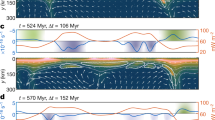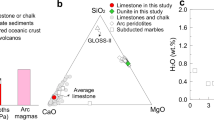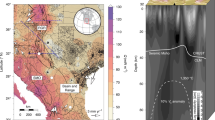Abstract
Continental rifts are important sources of mantle carbon dioxide (CO2) emission into Earth’s atmosphere1,2,3. Because deep carbon is stored for long periods in the lithospheric mantle4,5,6, rift CO2 flux depends on lithospheric processes that control melt and volatile transport1,3,7. The influence of compositional and thickness differences between Archaean and Proterozoic lithosphere on deep-carbon fluxes remains untested. Here we propose that displacement of carbon-enriched Tanzanian cratonic mantle concentrates deep carbon below parts of the East African Rift System. Sources and fluxes of CO2 and helium are examined over a 350-kilometre-long transect crossing the boundary between orogenic (Natron and Magadi basins) and cratonic (Balangida and Manyara basins) lithosphere from north to south. Areas of diffuse CO2 degassing exhibit increasing mantle CO2 flux and 3He/4He ratios as the rift transitions from Archaean (cratonic) to Proterozoic (orogenic) lithosphere. Active carbonatite magmatism also occurs near the craton edge. These data indicate that advection of the root of thick Archaean lithosphere laterally to the base of the much thinner adjacent Proterozoic lithosphere creates a zone of highly concentrated deep carbon. This mode of deep-carbon extraction may increase CO2 fluxes in some continental rifts, helping to control the production and location of carbonate-rich magmas.
This is a preview of subscription content, access via your institution
Access options
Access Nature and 54 other Nature Portfolio journals
Get Nature+, our best-value online-access subscription
$29.99 / 30 days
cancel any time
Subscribe to this journal
Receive 51 print issues and online access
$199.00 per year
only $3.90 per issue
Buy this article
- Purchase on Springer Link
- Instant access to full article PDF
Prices may be subject to local taxes which are calculated during checkout




Similar content being viewed by others
Data availability
All data generated or analysed during this study are provided with this article and in Supplementary Tables 1–4. The SRTM digital elevation model used to generate maps is publicly available at http://srtm.csi.cgiar.org/srtmdata. The recently analysed and previously unpublished CO2 flux and isotopic data (https://doi.org/10.26022/IEDA/111520) from the 2018 Tanzania field campaign can be found at http://www.earthchem.org.
References
Lee, H. et al. Massive and prolonged deep carbon emissions associated with continental rifting. Nat. Geosci. 9, 145–149 (2016).
Brune, S., Williams, S. E. & Müller, R. D. Potential links between continental rifting, CO2 degassing and climate change through time. Nat. Geosci. 10, 941–946 (2017).
Tamburello, G., Pondrelli, S., Chiodini, G. & Rouwet, D. Global-scale control of extensional tectonics on CO2 earth degassing. Nat. Commun. 9, 4608 (2018).
Dasgupta, R. & Hirschmann, M. M. The deep carbon cycle and melting in Earth’s interior. Earth Planet. Sci. Lett. 298, 1–13 (2010).
Kelemen, P. B. & Manning, C. E. Reevaluating carbon fluxes in subduction zones, what goes down, mostly comes up. Proc. Natl Acad. Sci. USA 112, E3997–E4006 (2015).
Foley, S. F. & Fischer, T. P. An essential role for continental rifts and lithosphere in the deep carbon cycle. Nat. Geosci. 10, 897–902 (2017).
Hunt, J. A., Zafu, A., Mather, T. A., Pyle, D. M. & Barry, P. H. Spatially variable CO2 degassing in the main Ethiopian rift: implications for magma storage, volatile transport, and rift-related emissions. Geochem. Geophys. Geosyst. 18, 3714–3737 (2017).
Malusà, M. G. et al. Active carbon sequestration in the Alpine mantle wedge and implications for long-term climate trends. Sci. Rep. 8, 4740–4748 (2018).
Foley, S. F. Rejuvenation and erosion of the cratonic lithosphere. Nat. Geosci. 1, 503–510 (2008).
Brantley, S. L. & Koepenick, K. W. Measured carbon-dioxide emissions from Oldoinyo Lengai and the skewed distribution of passive volcanic fluxes. Geology 23, 933–936 (1995).
Sawyer, G. M., Carn, S. A., Tsanev, V. I., Oppenheimer, C. & Burton, M. Investigation into magma degassing at Nyiragongo volcano, Democratic Republic of the Congo. Geochem. Geophys. Geosyst. 9, Q02017 (2008).
Hutchison, W. et al. Structural controls on fluid pathways in an active rift system: a case study of the Aluto volcanic complex. Geosphere 11, 542–562 (2015).
van Wijk, J., van Hunen, J. & Goes, S. Small-scale convection during continental rifting: evidence from the Rio Grande rift. Geology 36, 575–578 (2008).
Bastow, I. D., Keir, D. & Daly, E. The Ethiopia Afar Geoscientific Lithospheric Experiment (EAGLE): probing the transition from continental rifting to incipient seafloor spreading. Spec. Pap. Geol. Soc. Am. 478, 1–26 (2011).
Ebinger, C. J. & Sleep, N. H. Cenozoic magmatism throughout east Africa resulting from impact of a single plume. Nature 395, 788–791 (1998).
Foley, S. F., Link, K., Tiberindwa, J. V. & Barifaijo, E. Patterns and origin of igneous activity around the Tanzanian craton. J. Afr. Earth Sci. 62, 1–18 (2012).
Kalt, A., Hegner, E. & Satir, M. Nd, Sr, and Pb isotopic evidence for diverse lithospheric mantle sources of East African Rift carbonatites. Tectonophysics 278, 31–45 (1997).
Rosenthal, A., Foley, S. F., Pearson, D. G., Nowell, G. M. & Tappe, S. Petrogenesis of strongly alkaline primitive volcanic rocks at the propagating tip of the western branch of the East African Rift. Earth Planet. Sci. Lett. 284, 236–248 (2009).
Currie, C. A. & van Wijk, J. How craton margins are preserved: insights from geodynamic models. J. Geodyn. 100, 144–158 (2016).
Roecker, S. et al. Subsurface images of the Eastern Rift, Africa, from the joint inversion of body waves, surface waves and gravity: investigating the role of fluids in early-stage continental rifting. Geophys. J. Int. 210, 931–950 (2017).
Tiberi, C. et al. Lithospheric modification by extension and magmatism at the craton–orogenic boundary: north Tanzania divergence, East Africa. Geophys. J. Int. 216, 1693–1710 (2019).
Ebinger, C. J. et al. Crustal structure of active deformation zones in Africa: implications for global crustal processes. Tectonics 36, 3298–3332 (2017).
Lee, C. T. & Rudnick, R. L. Compositionally stratified cratonic lithosphere: petrology and geochemistry of peridotite xenoliths from the Labait tuff cone, Tanzania. In Proc. of the 7th International Kimberlite Conference (eds Gurney, J. J. & Richardson, S. R.) 503–309 (National Book Printers, 1999).
Vauchez, A., Dineur, F. & Rudnick, R. Microstructure, texture and seismic anisotropy of the lithospheric mantle above a mantle plume: insights from the Labait volcano xenoliths (Tanzania). Earth Planet. Sci. Lett. 232, 295–314 (2005).
Aulbach, S., Rudnick, R. L. & McDonough, W. F. Evolution of the lithospheric mantle beneath the East African Rift in Tanzania and its potential signatures in rift magmas. Spec. Pap. Geol. Soc. Am. 478, 105–125 (2011).
Weinstein, A. et al. Fault-magma interactions during early continental rifting: seismicity of the Magadi–Natron–Manyara basins, Africa. Geochem. Geophys. Geosyst. 18, 3662–3686 (2017).
Lee, H. et al. Incipient rifting accompanied by the release of subcontinental lithospheric mantle volatiles in the Magadi and Natron basin, East Africa. J. Volcanol. Geotherm. Res. 346, 118–133 (2017).
Gautheron, C. & Moreira, M. Helium signature of the subcontinental lithospheric mantle. Earth Planet. Sci. Lett. 199, 39–47 (2002).
Mana, S., Furman, T., Turrin, B. D., Feigenson, M. D. & Swisher, C. C. Magmatic activity across the East African North Tanzanian Divergence Zone. J. Geol. Soc. Lond. 172, 368–389 (2015).
Halldórsson, S. A., Hilton, D. R., Scarsi, P., Abebe, T. & Hopp, J. A common mantle plume source beneath the entire East African Rift System revealed by coupled helium- neon systematics. Geophys. Res. Lett. 41, 2304–2311 (2014).
Furman, T. et al. Heads and tails: 30 million years of the Afar plume. Geol. Soc. Lond. Spec. Publ. 259, 95–119 (2006).
Furman, T. Geochemistry of East African Rift basalts: an overview. J. Afr. Earth Sci. 48, 147–160 (2007).
Pik, R., Marty, B. & Hilton, D. R. How many mantle plumes in Africa? The geochemical point of view. Chem. Geol. 226, 100–114 (2006).
Hilton, D. R. et al. Helium isotopes at Rungwe Volcanic Province, Tanzania, and the origin of East African Plateaux. Geophys. Res. Lett. 38, L21304 (2011).
Selway, K. Negligible effect of hydrogen content on plate strength in East Africa. Nat. Geosci. 8, 543–546 (2015).
Koornneef, J. M. et al. Nature and timing of multiple metasomatic events in the sub-cratonic lithosphere beneath Labait, Tanzania. Lithos 112, 896–912 (2009).
Stachel, T. & Brey, G. P. Rare and unusual mineral inclusions in diamonds from Mwadui, Tanzania. Contrib. Mineral. Petrol. 132, 34–47 (1998).
Rudnick, R. L., Mcdonough, W. F. & Chappell, B. W. Carbonatite metasomatism in the northern Tanzanian mantle: petrographic and geochemical characteristics. Earth Planet. Sci. Lett. 114, 463–475 (1993).
Huismans, R. & Beaumont, C. Depth-dependent extension, two-stage breakup and cratonic underplating at rifted margins. Nature 473, 74–78 (2011).
Chesley, J. T., Rudnick, R. L. & Lee, C.-T. Re–Os systematics of mantle xenoliths from the East African Rift: age, structure, and history of the Tanzanian craton. Geochim. Cosmochim. Acta 63, 1203–1217 (1999).
Foley, S. F. et al. The composition of near-solidus melts of peridotite in the presence of CO2 and H2O between 40 and 60 kbar. Lithos 112, 274–283 (2009).
Conrad, C. P. & Behn, M. D. Constraints on lithosphere net rotation and asthenospheric viscosity from global mantle flow models and seismic anisotropy. Geochem. Geophys. Geosyst. 11, Q05W05 (2010).
Fischer, T. P. et al. Upper-mantle volatile chemistry at Oldoinyo Lengai volcano and the origin of carbonatites. Nature 459, 77–80 (2009).
Carn, S. A., Fioletov, V. E., McLinden, C. A., Li, C. & Krotkov, N. A. A decade of global volcanic SO2 emissions measured from space. Sci. Rep. 7, 44095 (2017).
Sawyer, G. M., Carn, S. A., Tsanev, V. I., Oppenheimer, C. & Burton, M. Investigation into magma degassing at Nyiragongo volcano, Democratic Republic of the Congo. Geochem. Geophys. Geosyst. 9, Q02017 (2008).
Eby, G. N., Lloyd, F. E. & Woolley, A. R. Geochemistry and petrogenesis of the Fort Portal, Uganda, extrusive carbonatite. Lithos 113, 785–800 (2009).
Roberts, E. M. et al. Initiation of the western branch of the East African Rift coeval with the eastern branch. Nat. Geosci. 5, 289–294 (2012).
Parks, M. M. et al. Distinguishing contributions to diffuse CO2 emissions in volcanic areas from magmatic degassing and thermal decarbonation using soil gas 222Rn–δ13C systematics: application to Santorini volcano, Greece. Earth Planet. Sci. Lett. 377, 180–190 (2013).
Kennett, B. L. N. & Engdahl, E. R. Traveltimes for global earthquake location and phase identification. Geophys. J. Int. 105, 429–465 (1991).
Dawson, J. B., James, D., Paslick, C. & Halliday, A. M. Ultrabasic potassic low-volume magmatism and continental rifting in north-central Tanzania: association with enhanced heat flow. Russ. Geol. Geophys. 38, 69–81 (1997).
Ibs-von Seht, M., Blumenstein, S., Wagner, R., Hollnack, D. & Wohlenberg, J. Seismicity, seismotectonics and crustal structure of the southern Kenya Rift—new data from the Lake Magadi area. Geophys. J. Int. 146, 439–453 (2001).
Ernst, R. E. & Bell, K. Large igneous provinces (LIPs) and carbonatites. Mineral. Petrol. 98, 55–76 (2010).
Hofmann, C. et al. Timing of the Ethiopian flood basalt event and implications for plume birth and global change. Nature 389, 838–841 (1997).
Rooney, T. O. The Cenozoic magmatism of East-Africa: Part I – flood basalts and pulsed magmatism. Lithos 286–287, 264–301 (2017).
Woolley, A. R. & Kjarsgaard, B. A. Carbonatite Occurrences of the World (Geological Survey of Canada, 2008).
Fairhead, J. D., Mitchell, J. G. & Williams, L. A. J. New K/Ar determinations on rift volcanics of S. Kenya and their bearing on age of rift faulting. Science 238, 66–69 (1972).
Le Gall, B. et al. Rift propagation at craton margin. Distribution of faulting and volcanism in the North Tanzanian Divergence (East Africa) during Neogene times. Tectonophysics 448, 1–19 (2008).
Muirhead, J. D. et al. Evolution of upper crustal faulting assisted by magmatic volatile release during early-stage continental rift development in the East African Rift. Geosphere 12, 1670–1700 (2016).
Sherrod, D. R., Magigita, M. M. & Kwelwa, S. Geologic Map of Oldonyo Lengai (Oldoinyo Lengai) and Surroundings, Arusha Region, United Republic of Tanzania. Report No. 1306 (U.S. Geological Survey, 2013).
Muirhead, J. D., Kattenhorn, S. A. & Le Corvec, N. Varying styles of magmatic strain accommodation in the East African Rift. Geochem. Geophys. Geosyst. 16, 2775– 2795 (2015).
Bagdasaryan, G., Gerasimovskiy, V. I., Polykov, A. I. & Gukasyan, R. K. Age of volcanic rocks in the rift zones of East Africa. Geokhimiya 1, 84–90 (1973).
Mollel, G. F. Petrochemistry and Geochronology of Ngorongoro Volcanic Highland Complex (NVHC) and its Relationship to Laetoli and Olduvai Gorge, Tanzania. PhD thesis, Rutgers Univ. (2007).
Burton, M. R., Sawyer, G. M. & Granieri, D. in Carbon in Earth (eds. Hazen, R. M. et al.) 323–354 (De Gruyter, 2013).
Sano, Y., Tokutake, T. & Takahata, N. Accurate measurement of atmospheric helium isotopes. Anal. Sci. 24, 521–525 (2008).
Chiodini, G., Cioni, R., Guidi, M., Raco, B. & Marini, L. Soil CO2 flux measurements in volcanic and geothermal areas. Appl. Geochem. 13, 543–552 (1998).
Chiodini, G. et al. Carbon isotopic composition of soil CO2 efflux, a powerful method to discriminate different sources feeding soil CO2 degassing in volcanic-hydrothermal areas. Earth Planet. Sci. Lett. 274, 372–379 (2008).
Sinclair, J. A. Selection of thresholds in geochemical data using probability graphs. J. Geochem. Explor. 3, 129–149 (1974).
Acknowledgements
This work was funded by the NSF EAR GeoPRISMS Program, grant numbers 1654518 (J.D.M.), 1654433 (T.P.F.) and 1836651 (J.D.), Deutsche Forschungsgemeinschaft (DFG) grant RE 4321/1-1 (M.C.R.) and the Marshall-Heape fund at Tulane University (C.J.E.). We are grateful to COSTECH and Tanzania Wildlife Research Institute for permitting us to conduct research in Tanzania. We thank E. Saria and K. Nkembo for assistance during fieldwork in the Lake Natron region in 2018, G. Kianji for assistance during collection of data in 2014, and K. Rahilly for assisting with field planning.
Author information
Authors and Affiliations
Contributions
The initial project was conceived by J.D.M., T.P.F., C.J.E. and J.D., with planning and execution of field data collection by J.D.M., T.P.F., C.J.E., A.L., S.J.O., E.K. and M.C.R. CO2 flux data were compiled and analysed by J.D.M., T.P.F., E.J.J., S.J.O. and A.L., and laboratory analyses of helium and carbon isotopes were performed by T.P.F., H.L., Y.S. and N.T. Compilation and examination of geophysical and gas chemical data were conducted by C.T., J.D.M., C.J.E., J.v.W. and C.A.C. The final model presented in Fig. 4 was conceived and designed by T.P.F., J.D.M., C.J.E., J.v.W., C.A.C. and S.F.F. The manuscript was written by J.D.M. and T.P.F. with contributions from all co-authors.
Corresponding authors
Ethics declarations
Competing interests
The authors declare no competing interests.
Additional information
Peer review information Nature thanks Sascha Brune, Giovanni Chiodini and Tanya Furman for their contribution to the peer review of this work.
Publisher’s note Springer Nature remains neutral with regard to jurisdictional claims in published maps and institutional affiliations.
Extended data figures and tables
Extended Data Fig. 1 Latitudinal variations in CO2 flux and RA values (3He/4He) with respect to the modelled lithosphere structure.
a, RA versus latitude along the Eastern Rift from −1.5° to −4.5°. Air-contaminated samples (TZ18-C16) were removed from the analysis. The Tanzanian craton boundary (light grey) is interpreted using the sharp density (c) and velocity (d) contrasts near the northern Manyara and southern Natron basins. It is marked as a broad region to account for location uncertainties and the overall three-dimensional nature of the boundary in the region. b, Diffuse CO2 flux versus latitude along the Eastern Rift from −1.5° to −4.5° for sample sites presented in Fig. 1a and the Oldoinyo Lengai volcano. c, Lithosphere density model from Tiberi et al.21. d, Lithosphere velocity model from Tiberi et al.21 (model resolution discussed in Methods). The density and velocity contrasts are relative to the IASP91 model49. The position of the cross-section is shown in Fig. 1a.
Extended Data Fig. 2 CO2 flux population analyses.
a–d, Shown are results for the Manyara (a), Natron (b), Magadi (c) and Balangida (d) basins. The analyses were performed in line with the method of Sinclair67 outlined in Chiodini et al.65, with the dashed lines representing a modelled mixed population based on the distributions of the lower, higher and occasionally intermediate flux populations.
Supplementary information
Supplementary Table 1
Data Table 1 provides a summary of diffuse CO2 flux data (g m-2 d-1) for the Magadi, Natron, Manyara, and Balangida basins (values presented as “<0.24” are below the detection limit of the flux meter).
Supplementary Table 2
Data Table 2 is a summary of carbon isotope data.
Supplementary Table 3
Data Table 3 provides a summary of helium isotope data.
Supplementary Table 4
Data Table 4 summarizes the carbonatite systems associated with the Tanzanian craton and EARS.
Rights and permissions
About this article
Cite this article
Muirhead, J.D., Fischer, T.P., Oliva, S.J. et al. Displaced cratonic mantle concentrates deep carbon during continental rifting. Nature 582, 67–72 (2020). https://doi.org/10.1038/s41586-020-2328-3
Received:
Accepted:
Published:
Issue Date:
DOI: https://doi.org/10.1038/s41586-020-2328-3
This article is cited by
-
All scales must be considered to understand rifts
Nature Reviews Earth & Environment (2023)
-
Geodynamics of continental rift initiation and evolution
Nature Reviews Earth & Environment (2023)
-
Dynamic modeling of tectonic carbon processes: State of the art and conceptual workflow
Science China Earth Sciences (2023)
-
An explosive component in a December 2020 Milan earthquake suggests outgassing of deeply recycled carbon
Communications Earth & Environment (2022)
-
Transient mobilization of subcrustal carbon coincident with Palaeocene–Eocene Thermal Maximum
Nature Geoscience (2022)
Comments
By submitting a comment you agree to abide by our Terms and Community Guidelines. If you find something abusive or that does not comply with our terms or guidelines please flag it as inappropriate.



